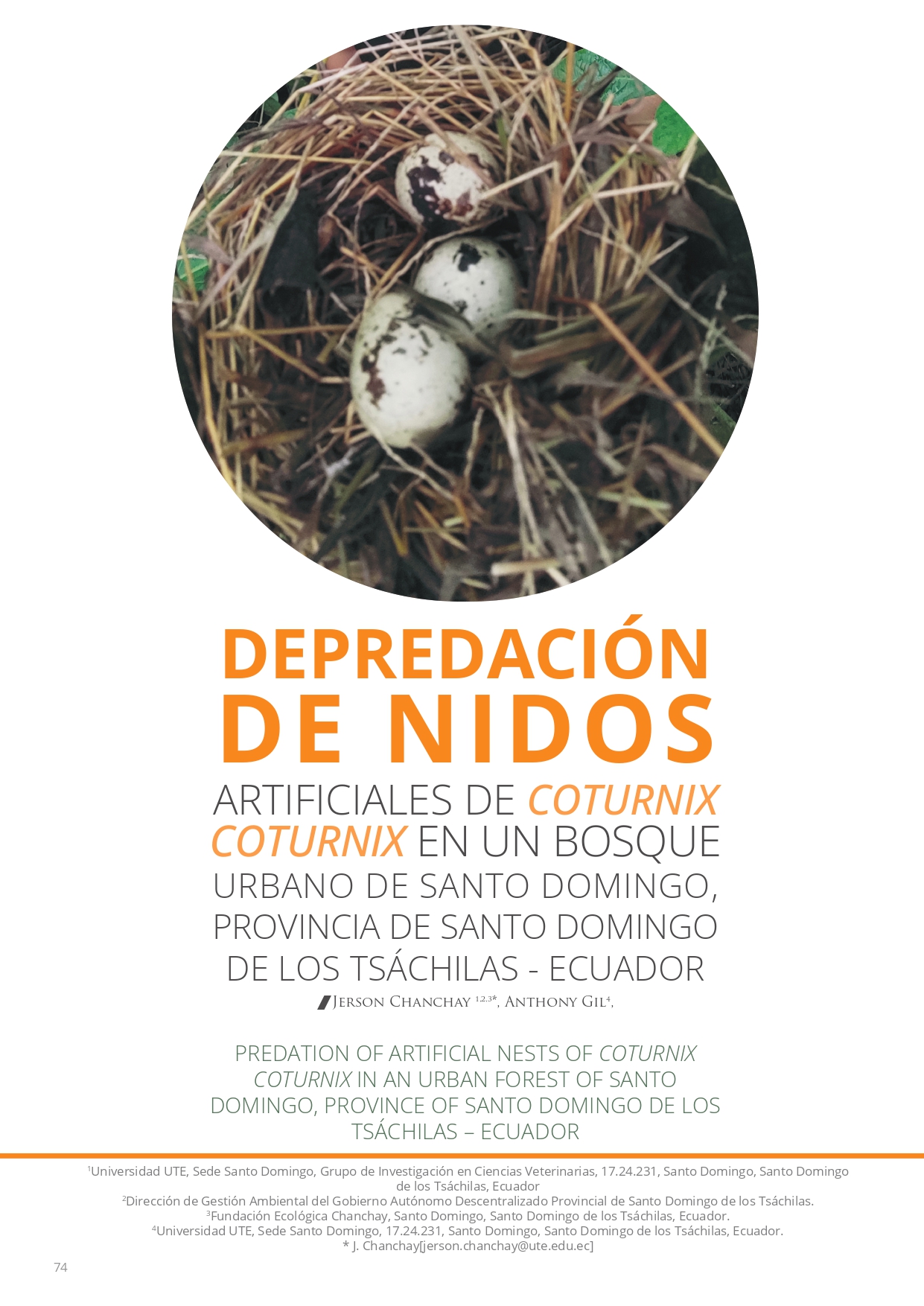Depredación de nidos artificiales de Coturnix coturnix en un bosque urbano de Santo Domingo, Provincia de Santo Domingo de los Tsáchilas - Ecuador
DOI:
https://doi.org/10.29105/bys7.14-132Keywords:
Ecosystem services, Ornithofauna, Sustainable cities, Urban wildlifeAbstract
Birds are a well-adapted group in urban environments, however, their conservation depends on the geographic and historical context of the city. In this sense, the survival capacity of the species will depend on different factors, among which is the predation of nests, for which the objective of the work was to analyze the levels of predation of bird nests within an urban forest of Santo Domingo in the province of Santo Domingo de Los Tsáchilas. Sixty artificial nests with Coturnix coturnix eggs were placed inside Chanchay Park. Some were placed on the ground, others on trees. The depletion was analyzed based on the days and number of eggs predated. In addition, a COX proportional hazard regression and Kaplan-Meier estimator were performed. The results show a significant relationship P = 0.005 in predation depending on the habitat, as the nests on the ground have higher predation, obtaining survival levels of less than 50% from the fifth day. On the other hand, spatial predation increases in places close to homes, which is why foragers could be associated with urban fauna such as dogs and cats. High levels of predation on the ground are repeated in other investigations, which is why conserving birds that nest on the ground becomes a challenge for local governments. Finally, guaranteeing the conservation of the diversity of ornithofauna in the city of Santo Domingo will depend on the management of local governments within the framework of their powers, whether controlling urban fauna or creating programs and projects for the conservation of wildlife.
Downloads
References
Alberti, M. 2008. ADVANCES IN URBAN ECOLOGY: Integrating Humans and Ecological Processes in Urban Ecosystems. University of Washington (ed.),. Springer, Washington.
Athanas, N., Greenfield, P.J. 2016. Birds of Western Ecuador A Photographic Guide. 1ra ed. Princeton University Press, New Jersey. DOI: https://doi.org/10.1515/9781400880706
Batary, P., Kurucz, K., Suarez-Rubio, M., Chamberlain, D.E. 2017. Non-linearities in bird responses across urbanization gradients: A meta-analysis. Glob Change Biol 24: 1046-1054. DOI: https://doi.org/10.1111/gcb.13964
Bayne, E.M., Hobson, K.A. 1997. Comparing the Effects of Landscape Fragmentation by Forestry and Agriculture on Predation of Artificial Nests. Conservation Biology 11: 1418-1429. DOI: https://doi.org/10.1046/j.1523-1739.1997.96135.x
Chanchay, J.R., Chanchay, D.L., Chanchay, J.M. 2019. De la teoría a la práctica: aportes de la Fundación Ecológica Chanchay en Santo Domingo. VÍNCULOS-ESPE 4: 9-14. DOI: https://doi.org/10.24133/vinculosespe.v4i2.1551
Cox, D.R. 1997. Regression models and life-tables. J. R Stat. Soc. 34: 187-202. DOI: https://doi.org/10.1111/j.2517-6161.1972.tb00899.x
Eötvös, C.B., Magura, T., Lövei, G.L. 2018. A meta-analysis indicates reduced predation pressure with increasing urbanization. Landscape and Urban Planning 180: 54-59. DOI: https://doi.org/10.1016/j.landurbplan.2018.08.010
Gerds, T.A. 2022. pec: Prediction Error Curves for Risk Prediction Models in Survival Analysis. 1-57.
Heezik, Y. van, Ludwig, K., Whitwell, S., McLean, I.G. 2008. Nest survival of birds in an urban environment in New Zealand. New Zealand Journal of Ecology 32: 155-165.
Jokimäki, J., Huhta, E. 2000. Artificial Nest Predation and Abundance of Birds Along an Urban Gradient. The Condor 102: 838–847. DOI: https://doi.org/10.1093/condor/102.4.838
Kaplan, E.L., Meier, P. 1958. Nonparametric estimation from incomplete observations. Journal of the American Statistical Association 53: 457-481. DOI: https://doi.org/10.1080/01621459.1958.10501452
Kassambara, A., Kosinski, M., Biecek, P., Fabian, S. 2021. survminer: Drawing Survival Curves using «ggplot2». 1-67.
Kurucz, K., Purger, J.J., Batáry, P. 2021. Urbanization shapes bird communities and nest survival, but not their food quantity. Global Ecology and Conservation 26: 2351-9894. DOI: https://doi.org/10.1016/j.gecco.2021.e01475
Pestana, G.C., Mateus-barros, E., Guillermo-, R., Pestana, G.C., Mateus-barros, E. 2020. The influence of parent body colouration and nesting habitat on bird nest predation. Bird Study 67: 29-34. DOI: https://doi.org/10.1080/00063657.2020.1733486
QGIS Development Team. 2022. QGIS Geographic Information System.
R Core Team. 2020. R: A language and environment for statistical computing.
Rasband, W. 2020. ImageJ. U. S. National Institutes of Health, Bethesda, Maryland, USA//imagej.nih.gov/ij/.
Saarinen, R.S., Suhonen, J. 2022. Community Structure and Nest Predation in Urban Parks and Rural Forest Patches. Available at SSRN. DOI: https://doi.org/10.2139/ssrn.4025977
Seto, C.K., Fragkias, M., Guneralp, B., Reilly, M. 2011. A Meta-Analysis of Global Urban Land Expansion Karen. PLoS ONE 6: 1-9. DOI: https://doi.org/10.1371/journal.pone.0023777
Therneau, T.M., Lumley, T., Atkinson, E., Crowson, C. 2022. Survival Analysis. 1-188.
Trnka, A., Prokop, P., Batáry, P. 2008. Dummy birds in artificial nest studies: an experiment with Red-backed Shrike Lanius collurio. Bird Study 55: 329-331. DOI: https://doi.org/10.1080/00063650809461539







